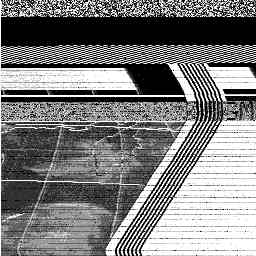WEFAX is a very old, very established, way of squeezing monochrome analogue still picture information through a standard voice audio channel. It uses a 2.4kHz carrier, amplitude modulated with a 1.6kHz band limited 'video' signal - here's what the signal looks & sounds like - click on the graphic to hear the clip.
The signal also includes frame start and stop tones and horizontal synchronization bursts for each raster line. The expanded section of waveform above shows one raster line with a horizontal sync burst at each end. The figure below is a section taken from a noise affected image which failed to synchronize correctly. It clearly shows both the horizontal and vertical framing sequences as well as a bit of very distorted image.

The composite audio signal is FM modulated by Meteosat onto a couple of 1.7GHz RF carriers and these are the signals we receive with our dish here at Nottingham. Our custom DSP based receiving gear monitors both channels simultaneously, listening for wefax start tones and acquiring all identifiable wefax images. The 800 active lines of an image each take 250ms to transmit, a whole picture therefore takes about three and half minutes. Meteosat could transmit one wefax picture every 4 minutes on each of its two transmission channels - but it doesn't. Some of its 4-minute slots are empty and many are used for encrypted digital transmissions, the rest, about 50%, are available for wefax images. A dissemination schedule is published by Eumetsat detailing what pictures are transmitted at which times and on what channel.
Each picture carries with it a couple of extra raster lines that contain digitally coded identification information. The graphic below is a tiny section of image with its identification data bits still showing - the row of little spots along the bottom.

Once decoded to ASCII it'll look something like this:
MET5 IR19509080830D2 0DEG EASTWhich identifies the wavelength (IR), the date (08/09/95), the time (08:30) and the image reference name (D2). We use this information to construct a filename and date/time stamp for the image. Each new picture can then be named, jpeg encoded, saved in the archive and copied to the web server - within seconds of its reception.
The volume of wefax data obtainable in this way is about 24*60/4 images per day. Assuming a compressed file size of 100KBytes, that's 36MBytes every day, or a CDROM full every two and a half weeks.
"Weather Satellite Reception" By Matjaz Vidmar Radio & Electronics World Jun 1983 pp57..59 Aug 1983 pp52..57 "Weather Fax Reception" By Keith Mitchell Radio & Electronics World Sep 1983 pp49..51 "Meteosat Earth Station" By M.L.Christieson Wireless World Jun 1979 pp60..64 Jul 1979 pp93..97 "Orbit predictions from satellite images" By M.L.Christieson Wireless World Dec 1980 pp53..55
WeatherWatch-UK RAE Lasham Airfield, Alton, Hants. GU34 5SH NOAA Information Service Washington, DC 20233 Eumetsat or Mr Gordon Bridge Am Eifengrund 45 Am Kavalleriesand 31 D-64242 D-64295 Darmstadt-Eberstadt Darmstadt Fax +49 6151 950-125 Germany Some other ESA / Eumetsat internet contacts can be found on our Meteosat page
TimeStep Weather Systems Ltd Wickhambrook Newmarket CB8 8QA 01440 820040 / 820485 www.time-step.com